Performance Fuel Cells & Surge Tank Plumbing
Performance Fuel Cells & Surge Tanks
What you need to know when modifying the fuel storage and/or supply system for performance applications.
Modifying or upgrading the fuel storage/supply system may either require:
- Renewing the Fuel Cell (to suit fuel volume, mounting location and other options) plus adding a Surge tank to suit the fuel supply requirements;
OR
- Utilising the existing fuel tank and adding a suitable Surge tank to accommodate the fuel pump configurations required for the vehicle’s new fuel system.
Typical selection of Fuel Cell volumes for track and strip applications.
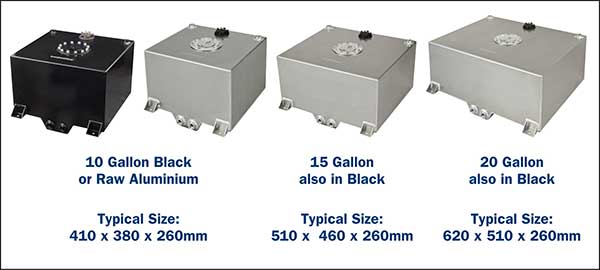
Note: These alloy fuel cells need to be of the highest quality to satisfy the racing and performance demands with both tank Inlets and outlets able to accommodate high fuel flow. The integrated fuel level sensor reduces any requirements for physical modifications to maintain the fuel cell’s structural integrity.
Our Raceworks fuel cells are custom ordered and current;y have an extended lead time - Inquire with your Autoignite rep before ordering.

Why do fuel cells internally utilise Fuel Cell Foam?

Fuel cell foam is generally regarded as being used to prevent fuel slosh (similar to a tank baffle affect) It is also used to stop a flame front from advancing, helping to eliminate the possibility of explosion.
Operation: Should the tank receive a sudden impact, the foam inside the fuel cell helps to dissipate and absorb a great amount of energy from the impact, reducing the risk of fuel cell rupture.
Note: The fuel cell should have no more than 75% of the area filled with foam as it expands upon contact with the fuel. Typical expected life of the foam may vary but generally up to 10 years without needing to be replaced. It is recommended however that the inline fuel filters be regularly checked for residue.
Typical Fuel Cell Plumbing option guide.
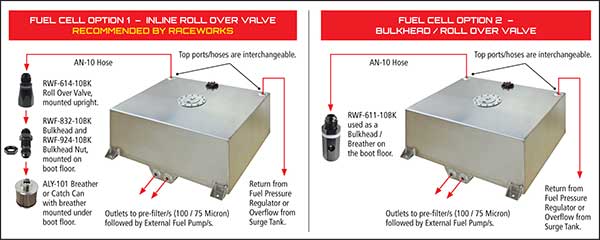
Why and how are Surge Tanks utilised?
There are conditions where a surge tank is required to ensure the correct fuel is supplied under all operating conditions.
- Where G forces acting on the vehicle may create fuel level issues at the intake point of the feed pump (of a conventional fuel tank) that may result in air entering and transferred to the main externally mounted fuel pump. This results in cavitation and can prematurely destroy the main pump causing lean running conditions. Fuel pump Cavitation that is the result of air/fuel supplied to the main pump is generally audible and is commonly identified as a noisy pump.
Normal operation of system without extreme forces acting on the vehicle.

Forces acting on the vehicle under certain conditions causing air in the fuel lines to the main external pump.
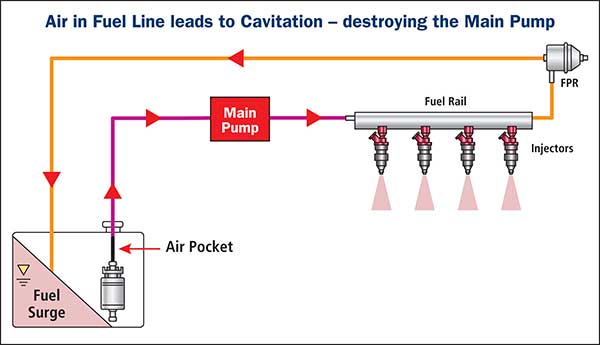
Fitting a Surge Tank to this standard system.
Fitting a surge tank requires selectng an option to suit the application.
- Option 1 - Locating the surge tank between the feed pump and the main pump and re-routing the return lines. The Fuel pressure regulator (FPR) in the return line helps to maintain the level of the surge tank to eliminate any cavitation affect.

Note: Replacing the intank feed pump with a high flow pump may be necessary for some applications.
- Option 2 - Removing the main external pump and fitting 1 or 2 in-tank fuel pumps in the Surge Tank.
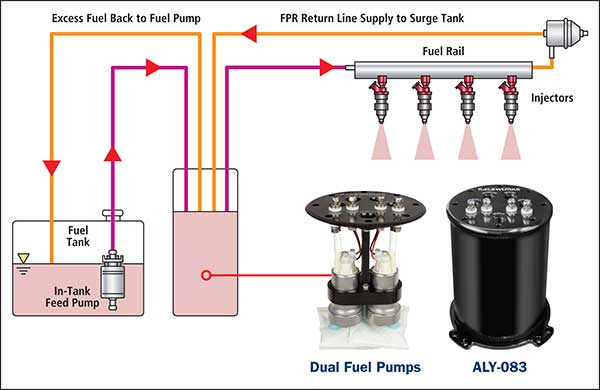
Note: The storage volume of the surge tank will vary depending on the pump quantities.
- 2.8L with Single pump
- 2.6L with Dual pumps.
Both inlets and outlets, like the fuel cells, must also accommodate high fuel flow.
Pump configurations.
The surge tank is generally compatible with the following fuel pumps.
TI Automotive (Walbro).
- 255 (GSS341 and GSS342)
- 460 (F90000262, F90000267 E85 and F90000274 E85)
Raceworks.
- EFP-500
- EFP-503
- EFP-504
- EFP-287
- EFP-324
- EFP-452
- EFP-057 (FSA-020 Fuel Pump Accessory Kit sold separately)
- EFP-058 (FSA-020 Fuel Pump Accessory Kit sold separately)
- EFP-420
- EFP-426
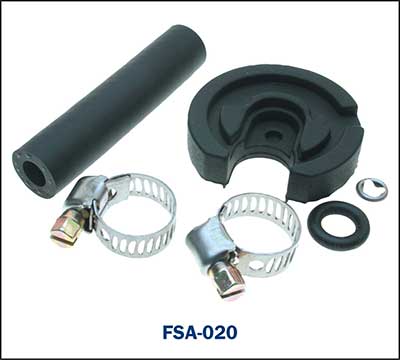
Fitting locations of a surge tank.
Typical locations for mounting the surge tank may vary with application. Generally they can be mounted in the boot area or attached to the frame rail.
A location that protects the surge tank from physical damage is recommended and not affected by heat.
It is imperative you speak to any issuing authority for compliance. i.e. NZ Motorsport, LVVTA, etc.
Autoignite offers a range of 8 Raceworks Fuel Cells, in sizes ranging from 5 Gallon (19L) to 20 Gallon (76L), and 8 Raceworks Surge Tanks, suitable for both in-tank and external pumps. When used with twin pumps from the TI Automotive range, these tanks can deliver fuel that supports an application up to 2500HP, and are safe for various fuels including Gasoline, Ethanol and Methanol.

